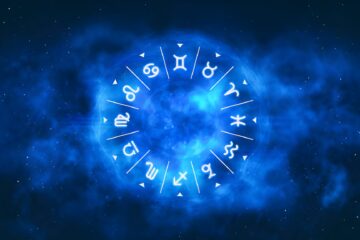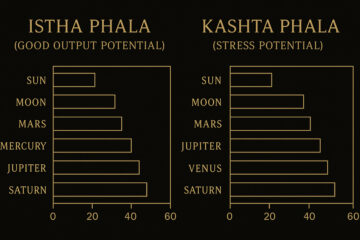Planetary aspects in Vedic astrology, or drishti, are how planets reach across the chart and influence houses and other planets from a distance. Bhaav aspects tell us where a house is going to stay active, where help arrives, and where pressure will show up over time. In practice, once you understand planetary aspects in Vedic astrology, you stop reading a chart only by “what sits in each house” and start reading “who is feeding that house, and with how much intensity.” That shift is where real Jyotish starts to feel alive.
In this guide, we’ll walk through core Parashari drishti rules, a practical system for weighting Bhaav aspects, what to do with Rahu and Ketu, how to build an aspect score for each house, and how to interpret benefic vs malefic influence realistically. We’ll also talk about timing, dignity, functional nature, and why a tough aspect on an upachaya bhaav (3rd, 6th, 10th, 11th) can still deliver growth rather than doom.
Why Bhaav Aspects Matter in House Judgement
A lot of students start by memorizing “Saturn in the 7th means X” or “Venus in the 10th means Y.” That’s fine at step one, but it’s incomplete. Because planetary aspects in Vedic astrology ensure that every house (bhaav) is influenced by planets that may not be physically sitting there. This matters for prediction. A house with no planets can still be extremely active if it’s being blasted by multiple strong aspects. A house with planets can still struggle if the incoming aspects are overwhelmingly obstructive.
So: you must learn to read both placement and drishti. The beauty of Bhaav aspects is that they’re not mystical; they’re systematic and you can grade them.
Classical Cornerstones of Bhaav Aspects
Let’s start with the classical rules. These are not optional. They are the backbone of how we read planetary aspects in Vedic astrology:
- Every planet aspects the 7th house from itself. This “opposition aspect” is universal. No exceptions.
- Mars throws strong aspects on the 4th and 8th houses from itself (in addition to the 7th). These are considered full-force aspects, not weak glances.
- Jupiter throws strong aspects on the 5th and 9th houses from itself (in addition to the 7th). These are read as benefic, guiding, protective — unless Jupiter is functionally malefic for that Lagna.
- Saturn throws strong aspects on the 3rd and 10th houses from itself (in addition to the 7th). These are often experienced as pressure, obligation, or demand — but that pressure can also produce endurance and structure.
Classical texts treat these special aspects (Mars 4th/8th, Jupiter 5th/9th, Saturn 3rd/10th) as full-power drishti — basically 100% influence. Jupiter does not “sort of” aspect the 5th. Jupiter fully aspects the 5th. Saturn does not “sort of” aspect the 10th. Saturn fully aspects the 10th.
Notice that these rules are house-based (bhaav-based). We are not just talking sign-to-sign; we are talking the house number counted from the planet. That’s why we call them Bhaav aspects: we’re interested in which houses are lit up.
Partial Aspects and Weighted Influence
In practice, especially for prediction and counseling, we often want nuance. Not every aspect is all-or-nothing. You may want to quantify how loudly a house is being activated. Below is a practical weighting model for Bhaav aspects. It’s a teaching framework — adapt it as you back-test charts:
- Planet sitting in the house itself: 100 (full influence). If a planet physically occupies a bhaav, that bhaav is undeniably active.
- Exact full aspect / exact alignment to that house’s center: 100. For example, Jupiter exactly trinal (5th or 9th) to that bhaav’s center, or Saturn exactly 10th to that bhaav’s center.
- 5th and 9th houses from a planet: 50 (half-aspect) for most planets, but for Jupiter it’s 100, because Jupiter’s 5th and 9th aspects are classically full-strength blessings/guidance.
- 4th and 8th houses from a planet: 75 (three-quarter strength). This category helps you capture that “Mars-like intensity” when other planets push into the 4th/8th dynamic. Mars itself is still treated as full power on 4th/8th, but this 75 score is a workable generalization for other grahas.
- 3rd house from a planet: 33 (one-third strength) for most planets. Saturn is the big exception: Saturn’s 3rd aspect is treated as 100 because tradition considers it a full-pressure gaze.
- 10th house from a planet: 25 (one-quarter strength). Again, Saturn’s 10th aspect is treated as full power (100), but other planets do cast a weaker awareness or demand toward the 10th-from-them position, so you can log a 25 for background influence.
This is not dogma. It’s a disciplined scoring system that lets you compare houses. You’re basically creating a “house activation profile” — which bhaavs are blazing with attention, which bhaavs are quiet.
Do Rahu and Ketu Aspect? (The Node Debate)
Rahu and Ketu are controversial in the context of planetary aspects in Vedic astrology. Classical Parashara uses physical planets for drishti. Nodes are shadow points, not physical bodies, so there’s disagreement on how to treat their aspects.
A cautious and practical stance you can follow:
- Treat Rahu and Ketu as having meaningful 5th and 9th “influences,” but not necessarily full, all-sign blanket aspects.
- Watch for the nodes to behave most clearly when the target planet sits in the nakshatra of the node’s dispositor (or, said plainly, when there is a tight nakshatra-level link). In those cases, Rahu can behave almost like an obsessive amplifier, and Ketu like an intense purifier.
- Some astrologers read Ketu like Mars (4th/8th aspects). Others ignore node aspects entirely. The key is: pick a method, note your rule in the chart notes, and test it against real lives. Consistency matters more than dogma.
Bottom line: with nodes, be transparent. Tell the client or student which interpretive rule you’re using, and stay consistent as you validate across charts.
Degrees, Bhaav Madhya, and Orb Strength
Now we get into why two charts can look “the same” on paper but feel totally different in lived experience. The degree — how close an aspect is to the bhaav madhya (house center) or to the exact aspectal angle — matters a lot.
Here’s a practical working rule for orbs when you score planetary aspects in Vedic astrology:
- Very strong / decisive influence: within about 3–5 degrees of the exact aspect line or bhaav madhya.
- Strong but tapering: within about 6–12 degrees.
- Noticeable but diffuse: around 12–15+ degrees. Beyond ~15 degrees, that specific aspect is usually weak for that specific house.
These are heuristics, not commandments. You refine them with case studies. But if you’re building a bhaav aspect score table, you’ll quickly notice that close, tight, high-weight aspects dominate how that house manifests in the native’s life story.
How to Judge Whether an Aspect Is Supportive or Harmful
This is where students get nervous: “Okay, I see Saturn aspecting my 10th. Is that bad?” The honest answer: not automatically. You have to blend multiple factors to label an aspect as positive, neutral, or obstructive. The four-part test looks like this:
- 1. Natural character: Is the planet a natural benefic (Jupiter, Venus, well-placed Moon, Mercury when not afflicted) or a natural malefic (Saturn, Mars, Sun, nodes)?
- 2. Functional role for this Lagna: Is the planet a yoga karaka (ruling a Kendra + Trikona), or a functional malefic (ruling dusthanas like 6, 8, 12)? Functional nature can flip your expectation. A “benefic” can be harmful if it’s a functional malefic for your ascendant.
- 3. Permanent friendships: Are the planets involved natural friends or enemies by classical rulership relationships? (For example, Sun and Saturn are not friends.)
- 4. Temporary friendships: In this specific chart, are the planets favorably disposed through sign exchange, mutual receptions, or shared dispositors?
Only after blending all four do you give that aspect a sign: +1 (supportive), 0 (neutral), -1 (obstructive). This is how you keep yourself from lazy assumptions like “Saturn is always bad” or “Jupiter is always good.” Reality is more layered. Jyotish expects you to read that layering.
Bhaav Aspect Scoring: Step-by-Step Method
Here’s a repeatable workflow you can use to quantify planetary aspects in Vedic astrology and compare which houses are actually loud in someone’s life:
Step 1. Start with the House Itself
List all planets physically placed in that bhaav. Give each a base score of 100 for direct occupation. This matters: software tables often skip this and only list “incoming” aspects. Do not forget the planet that’s sitting right there.
Step 2. Add Incoming Aspects
For each other planet, note how it aspects this bhaav. Use the weights:
- 100 for full aspects (e.g., Jupiter to 5th/9th, Mars to 4th/8th, Saturn to 3rd/10th, universal 7th aspect when exact).
- 75 for strong 4th/8th style pushes from non-Mars planets when you want to acknowledge heavy tension.
- 50 for 5th/9th general influence from non-Jupiter planets.
- 33 for 3rd-house influence from non-Saturn planets.
- 25 for background 10th-house awareness from non-Saturn planets.
Adjust for orb strength. If the aspect is extremely tight — within 3–5 degrees of the bhaav madhya or exact aspect line — you treat that contribution as especially decisive in interpretation.
Step 3. Assign Quality (+1 / 0 / -1)
For each contributing planet, ask: is this influence mostly supportive, mostly neutral, or mostly obstructive for this native? That judgment must consider:
- Natural benefic/malefic nature,
- Functional role in this chart (yoga karaka vs functional malefic),
- Dignity (own sign, exalted, combust, debilitated),
- Friend/enemy relationships in this specific placement,
- Divisional strength (D9, D10) if relevant.
Then tag the planet’s contribution as +1 (supportive), 0 (neutral), or -1 (obstructing).
Step 4. Multiply and Sum
Multiply each planet’s weight by its sign (+1 / 0 / -1). Add them all up. That total is your net aspect score for that bhaav. You can also track separate “positive total,” “negative total,” and “neutral total” to understand not only how active a house is, but how that activity feels to the person.
Interpreting the House Scores
Here’s one practical scale you can try. You can tune these thresholds over time as you build your own library of charts:
- Net score > 400: This house is highly prominent and tends to manifest early, loudly, and repeatedly. Life keeps circling back here.
- 300–400: Strong, reliable activation. The matters of this house are important plotlines in the person’s life.
- 150–300: Moderate. The house does show up, but often later in life, intermittently, or under specific dashas/transits rather than constantly.
- < 150 (or < 300 in stricter systems): Weaker baseline activation. The house might remain quieter, or its themes may feel less urgent, unless timing tools (dasha, transit) light it up.
Example interpretation: Suppose the 6th and 8th houses both score under ~300 while your 10th is 450+ and the 2nd is 380. You’re probably not someone whose life is dominated by constant crisis, litigation, chronic illness, or sudden breakdown (6th/8th stuff). Instead, the story is career/visibility (10th) and money/resources (2nd). Conversely, if the 3rd house has mostly negative-weight aspects and scores high on “tension,” you may find recurring themes around siblings, courage, self-assertion, or effort — often with conflict or pressure built into that storyline.
Practical Cautions and Refinements
We’ve built a scoring system, but Jyotish still demands synthesis. Here are critical refinements when applying planetary aspects in Vedic astrology:
Always check from multiple reference lagnas: Read the same house from the Ascendant, from Moon Lagna, and from Arudha Lagna (AL). If a house theme repeats across two or three reference lagnas with high aspect scores, it’s karmically confirmed.
Judge the bhaav lord: A strong house lord (own sign, exalted, high shadbala, solid dignity in Navamsa or the relevant divisional chart like D10 for career) can compensate for rough aspects. A weak lord plus harsh aspects is where you proceed with caution in counseling.
Upachaya houses mature through struggle: The 3rd, 6th, 10th, and 11th are upachaya houses. Malefic aspects here are not necessarily “bad.” Mars or Saturn hitting the 3rd can produce relentless drive. Saturn hitting the 10th can build career authority through discipline and endurance. Rahu hitting the 11th can produce gains through unconventional networks. Painful? Sometimes. Pointless? Rarely.
Dashas propose, transits dispose:
A house with a massive score may still feel “dormant” until the dasha of its lord or of a major aspecting planet activates it. Then transits of slow movers (Saturn, Jupiter, Rahu, Ketu) make it visible. So don’t assume “big score = right now.” Timing tools still rule manifestation.
Software is helpful but incomplete: Many astrology programs will spit out an aspect table that ignores the planet physically sitting in the house. Always add 100 for in-house occupation when you’re hand-scoring. Also confirm what the software calls a “full aspect” — some programs only count classical full aspects and skip partials.
Divisional charts refine the flavor: D1 (Rasi) is king for baseline promises. D9 (Navamsa) refines dharma/marriage maturity, D10 (Dasamsa) refines career expression. Aspects you see clearly in D1 that repeat in the relevant divisional chart matter more. If they don’t repeat, treat the divisional result as nuance, not override.
Final mindset: you’re not here to dump binary good/bad labels. You’re here to map pressure and support, then counsel realistically. That is the ethical use of planetary aspects in Vedic astrology.
Important Notes
How do Rahu and Ketu aspect the 5th and 9th houses?
The node question is famously debated. A practical approach for working astrologers is: treat Rahu and Ketu as giving usable 5th/9th influence mostly when the target planet is tied to the node’s nakshatra dispositor. In those cases Rahu behaves like an amplifier, Ketu like a purifier. Some astrologers also treat Ketu like Mars, giving 4th/8th aspects. Others ignore node aspects completely. Pick a rule set, document it, and test it on charts for consistency instead of treating it as gospel.
Does the quality of an aspect depend only on the planet’s nature?
No. A planet’s natural nature (benefic or malefic) is just the first layer. You must also evaluate functional role for the Lagna (yoga karaka vs functional malefic), dignity (own sign, exalted, combust, debilitated), friendships, and divisional strength. A so-called benefic with bad functional rulership can still cause trouble. A so-called malefic with yoga-karaka status can uplift through hard work. You only label an aspect as supportive or obstructive after blending all of that.
Which chart should I trust when placements differ, Rasi or Bhava Chalit?
For Bhaav aspects and house activation, Bhava Chalit (house-centered placement) is often more accurate because it tells you which house is actually being occupied and aspected by degree. The Rasi chart still matters for sign dignity, temperament, and planetary nature. In practice: use Bhava Chalit for “which house gets hit,” and use Rasi for “what flavor does the planet carry.” This combination is standard in serious predictive work.
How important are degrees and bhaav madhya for aspect strength?
Very. An aspect that hits within 3–5 degrees of the bhaav madhya or exact aspect angle is decisive. Within 6–12 degrees is still strong, just less surgical. Beyond ~15 degrees it becomes diffuse. This is one of the easiest upgrades you can make: stop treating all aspects as equal, and start caring about exactness.
Are malefic aspects on the 3rd and 11th houses always harmful?
Not necessarily. The 3rd and 11th are upachaya houses — they improve through effort. A malefic aspect on the 3rd can give raw courage, hustle, “I will do this myself.” A malefic aspect on the 11th can still deliver networks and income, but usually through grind, politics, or volatility. Watch dashas and transits. Watch the dignity of the house lord. Effort-heavy does not mean doomed.
My software shows an aspect table but ignores the planet sitting in the house. What do I do?
Add it manually. In any scoring table you build, the planet physically in the house should get a full 100 influence on that house. Many programs only list incoming aspects, which can trick beginners into thinking an “empty” house is quiet. It’s not empty if something is literally inside it.
Do aspects matter in divisional charts like D9 and D10?
Yes, but with nuance. D1 (Rasi) is still the backbone. Divisional drishti refines theme and domain. If a certain house gets blasted in D1 and the same theme repeats in D9 or D10, that repetition matters a lot. If it only shows in the divisional, treat it as a sub-theme that will surface under specific dashas for that life area (marriage in D9, career in D10), not as a universal life condition.
FAQ
Should I use fixed weights for aspects, or adapt them per chart?
Start with fixed weights — 100 for full aspects, 75/50/33/25 for partials — so you have a clean baseline. This gives you repeatability and helps you compare charts. As you gain experience, you’ll absolutely tweak the numbers. Some astrologers raise the 10th-house influence to 33, others drop the 4th/8th weight to 60. That’s okay. Build discipline first, then personalize.
Do Rahu and Ketu always behave the same way?
No. Nodes are context-driven. Rahu amplifies, exaggerates, externalizes, obsesses. Ketu internalizes, purifies, detaches. Whether they “aspect” in your system depends on your chosen node rule. Many astrologers find it most reliable to interpret nodes through their dispositors and nakshatra lords rather than pretend they behave exactly like Mars or Jupiter. Keep notes on what you see in real charts.
How do I decide if an aspect is benefic or malefic for this native?
Blend (1) natural nature, (2) functional nature for the Lagna, and (3) dignity + friendships. If a planet is a yoga karaka and dignified, its aspect can uplift even when it’s a natural malefic. If a planet is a functional malefic and also combust/debilitated, its aspect can obstruct even if it’s “supposed to be benefic.” Context is everything. Do not declare good/bad in isolation.
If a house has a huge total aspect weight, does that always mean it will manifest?
Yes in terms of prominence, but not always in terms of comfort. A house flooded by harsh, negative-weight aspects will manifest through conflict, pressure, loss, or karmic struggle. A house with mostly positive-weight aspects will manifest more gracefully. The house will be loud either way; the difference is tone. This is exactly why we track +1 / 0 / -1 along with raw weight.
Can I rely entirely on software for aspect scoring?
No. Software is good at listing classical drishti, but it can’t judge functional benefic vs functional malefic, combustion, dignity in divisional charts, or the quality of the relationship between planets. It also often ignores the planet actually sitting in the house. Use software as an assistant, not a final authority. You are still the astrologer.
Stay With Much Needed Astro
Much Needed Astro teaches you how to work with planetary aspects in Vedic astrology in a grounded way — not superstition, not fatalism. You learn to map Bhaav aspects, judge benefic vs functional malefic influence, weigh upachaya houses, and tie everything back to dashas and transits so you can actually time results in real life.
If you’re serious about studying real Jyotish, stay with Much Needed Astro — no fluff, no fear-mongering, just clarity you can actually use.
“`



